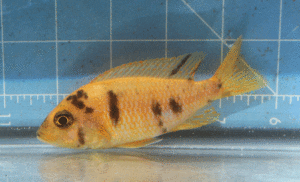Photo: One of our two current male breeder Orange OB Peacock Cichlids.
We just processed our Orange OB Peacock Cichlids. For a discussion of the development of this and other strains of peacock cichlids, see http://goliadfarms.com/our-peacock-cichlids/.
I did a very tight selection on this strain, using only two males and 21 females. I purged nearly that many females because they weren’t orange enough. All of the retained females are nicely orange. Below is pictured one of the young females. She’d just spit out fry and is a bit thin and color faded, but after all she’d just carried about 20 eggs and then fry in her mouth for about three weeks and didn’t eat well while doing so. And human females complain…

This strain has gotten to the point where the females are almost as colorful as the males. In fact, Susie, my wife and hatchery partner, who has no trouble with sexing other cichlids can’t reliably sex them so I have to do that. The pictured female is not nearly as orange as most of the other breeder females due to her young age and recent batch of fry. I should have taken photos of older, more colorful females. I’ll try to do that next time. I dislike photography and will probably do a rant about it soon since Susie is insisting I take up to date pictures.
The male in the photo above is nice but the second breeder male, who is very young, is going to be spectacularly orange. It is likely he’ll get all the females next cycle. Each breeding cycle lasts three to four months, somewhat longer in the winter due to shorter day length (we don’t use artificial lighting, just natural sunlight) and cooler water temperatures.
Typically with our peacock cichlids we use one to two males with 40-60 females. At one time we used six males in each breeding colony, but that led to too many females being lost because that many males in a 300 gallon vat harassed the females too much. I’ve found having no more than two male cichlids in a breeding colony works well. With one male there can be no male-male aggression; but, surprisingly, two males seem to get along well. They usually hang out together while the females stay on the other side of the vat. Both males seem to have mating opportunities and any time there is a dispute there’s enough space for both while the females can still avoid the males.
Those of you who have followed my past writings or attended any of my aquarium club talks may wonder about my change of recommendation about the numbers of males in a breeding colony. You might remember I once recommended using either one male or six plus males to reduce male-male aggression. Well…I might have been wrong. Since I’ve started using a maximum of two males per breeding colony, our breeder female fatalities have gone down and the number of harvested juveniles has gone up. Now, Susie will tell you I can’t admit to making mistakes, but I just did.
Good fishkeeping!


Leave a Reply